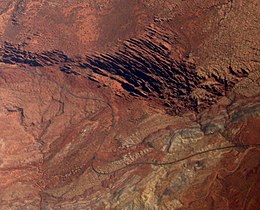Fiery Furnace (Arches National Park)
The Fiery Furnace is a collection of narrow sandstone canyons, fins and natural arches located near the center of Arches National Park in Utah, United States.

The area is a popular hiking destination that was named for the reddish hue it exhibits in sunset light.[1] Arches National Park has more than 2,000 cataloged sandstone arches,[2] with some being located in the Fiery Furnace, including Walk Through Arch, Crawl Through Arch, Skull Arch, Kissing Turtles Arch, and Surprise Arch.[3]
Ecology
[edit]The Fiery Furnace contains a variety of plant species, including one of the largest known concentrations of Canyonlands biscuitroot.[4] Fragile ecological features such as biological soil crust and ephemeral pools are also found within the Fiery Furnace, and are vulnerable to visitor impact.[5]
Visitor Access
[edit]Due to the environmental impacts of heavy visitation, the National Park Service initiated a permit system in 1994 to limit access to the Fiery Furnace.[6] Visitors may purchase permits to hike in the Fiery Furnace alone or join a ranger-guided tour.[7] Two trails lead hikers from the parking lot into the Fiery Furnace, but once inside, hikers must navigate the trailless labyrinth of rock formations.[8] To minimize impact on the plant communities, visitors must walk along sandy washes or on sandstone surfaces. During the approximately 2 mi (3.2 km) ranger-guided tour, which lasts about three hours, visitors will encounter uneven terrain, drop-offs, and narrow passages.[9] Rangers describe the history of the area, while noting the most prominent arches and other geologic features.[10] Visitors can also choose to obtain a self-guided permit and hike through the Fiery Furnace on their own; however, they are required to watch an orientation video describing the area and how to minimize their impact.[11]
Gallery
[edit]-
Aerial view with park road along bottom
-
Skull Arch
-
Juniper tree
-
Surprise Arch with tour guide
-
Panorama
References
[edit]- ^ Schneider, Bill (2017). Hiking Canyonlands and Arches National Park. Lanham, MD: Rowman & Littlefield. p. 64. ISBN 978-1493027385.
- ^ "Arches". National Park Service. Retrieved 2 November 2019.
- ^ Malitz, Jerome; Malitz, Susan (2005). Arches National Park Dayhiker's Guide. Boulder, CO: Big Earth Publishing. ISBN 1555663362. Retrieved 2 November 2019.
- ^ "Visitor Experience and Resource Protection Implementation Plan" (PDF). Coastal Training Program: Elkhorn Slough. Retrieved 2 November 2019.
- ^ "Why is the Fiery Furnace So Special?". Fiery Furnace Tour. Retrieved 2 November 2019.
- ^ Schneider, Bill (2017). Hiking Canyonlands and Arches National Park. Lanham, MD: Rowman & Littlefield. p. 64. ISBN 978-1493027385.
- ^ "Fiery Furnace Hikes: Go With a Ranger". National Park Service. Retrieved 2 November 2019.
- ^ Malitz, Jerome; Malitz, Susan (2005). Arches National Park Dayhiker's Guide. Boulder, CO: Big Earth Publishing. ISBN 1555663362. Retrieved 2 November 2019.
- ^ "Fiery Furnace Hikes: Go With a Ranger". National Park Service. Retrieved 2 November 2019.
- ^ Malitz, Jerome; Malitz, Susan (2005). Arches National Park Dayhiker's Guide. Boulder, CO: Big Earth Publishing. ISBN 1555663362. Retrieved 2 November 2019.
- ^ "Fiery Furnace Permits: Go on your own". National Park Service. Retrieved 2 November 2019.
External links
[edit]- Arches National Park - Ranger-led Programs
- Arches National Park - Fiery Furnace Photo Gallery
- Fiery Furnace satellite photo at Google Maps
38°45′03″N 109°34′01″W / 38.75083°N 109.56694°W





